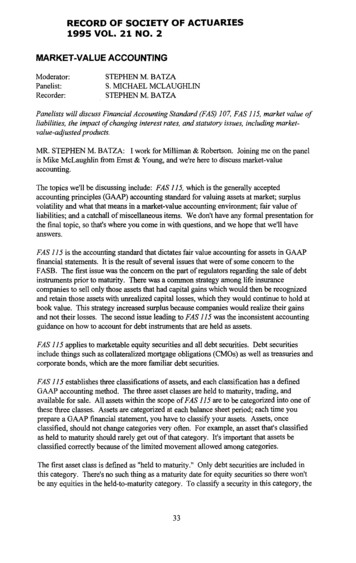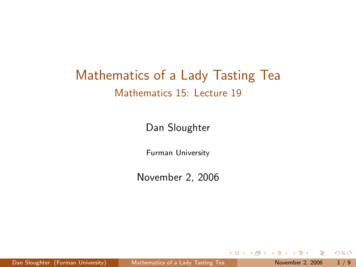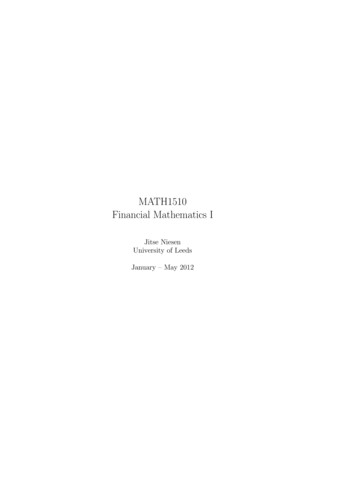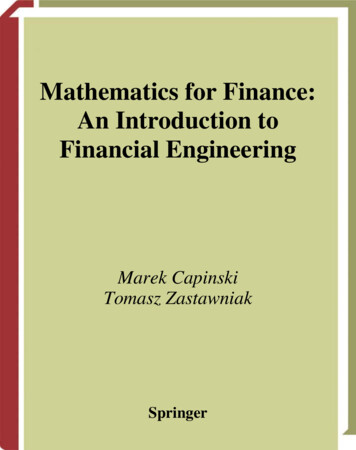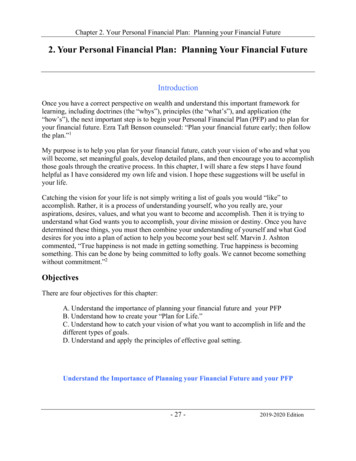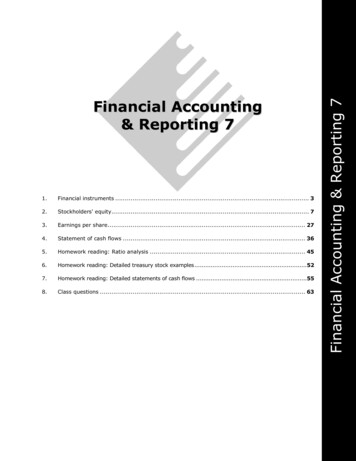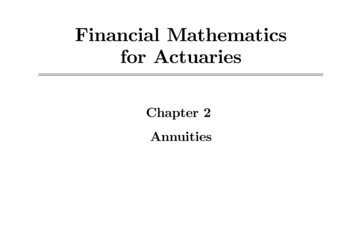
Transcription
Financial Mathematicsfor ActuariesChapter 2Annuities
Learning Objectives1. Annuity-immediate and annuity-due2. Present and future values of annuities3. Perpetuities and deferred annuities4. Other accumulation methods5. Payment periods and compounding periods6. Varying annuities2
2.1 Annuity-Immediate Consider an annuity with payments of 1 unit each, made at the endof every year for n years. This kind of annuity is called an annuity-immediate (also calledan ordinary annuity or an annuity in arrears). The present value of an annuity is the sum of the present valuesof each payment.Example 2.1: Calculate the present value of an annuity-immediate ofamount 100 paid annually for 5 years at the rate of interest of 9%.Solution: Table 2.1 summarizes the present values of the payments aswell as their total.3
Table 2.1:Year12345Present value of annuityPayment ( )Present value ( )100 (1.09) 1100 (1.09) 2100 (1.09) 3100 (1.09) 4100 (1.09) 5100100100100100Total 91.74 84.17 77.22 70.84 64.99388.972 We are interested in the value of the annuity at time 0, called thepresent value, and the accumulated value of the annuity at time n,called the future value.4
Suppose the rate of interest per period is i, and we assume thecompound-interest method applies. Let anei denote the present value of the annuity, which is sometimesdenoted as ane when the rate of interest is understood. As the present value of the jth payment is v j , where v 1/(1 i) isthe discount factor, the present value of the annuity is (see AppendixA.5 for the sum of a geometric progression)ane v v 2 v 3 · · · v n 1 vn v 1 v1 vn i1 (1 i) n .i5(2.1)
The accumulated value of the annuity at time n is denoted by sneior sne . This is the future value of ane at time n. Thus, we havesne ane (1 i)n(1 i)n 1 .i(2.2) If the annuity is of level payments of P , the present and future valuesof the annuity are P ane and P sne , respectively.Example 2.2: Calculate the present value of an annuity-immediate ofamount 100 paid annually for 5 years at the rate of interest of 9% usingformula (2.1). Also calculate its future value at time 5.6
Solution:From (2.1), the present value of the annuity is" 51 (1.09)100 a5e 100 0.09# 388.97,which agrees with the solution of Example 2.1. The future value of theannuity is(1.09)5 (100 a5e ) (1.09)5 388.97 598.47.Alternatively, the future value can be calculated as"5#(1.09) 1100 s5e 100 598.47.0.092Example 2.3: Calculate the present value of an annuity-immediate ofamount 100 payable quarterly for 10 years at the annual rate of interest7
of 8% convertible quarterly. Also calculate its future value at the end of10 years.Solution: Note that the rate of interest per payment period (quarter)is (8/4)% 2%, and there are 4 10 40 payments. Thus, from (2.1)the present value of the annuity-immediate is100 a40e0.02 100 " 401 (1.02)0.02# 2,735.55,and the future value of the annuity-immediate is2735.55 (1.02)40 6,040.20.2 A common problem in financial management is to determine the installments required to pay back a loan. We may use (2.1) to calculatethe amount of level installments required.8
Example 2.4: A man borrows a loan of 20,000 to purchase a car atannual rate of interest of 6%. He will pay back the loan through monthlyinstallments over 5 years, with the first installment to be made one monthafter the release of the loan. What is the monthly installment he needs topay?Solution: The rate of interest per payment period is (6/12)% 0.5%.Let P be the monthly installment. As there are 5 12 60 payments,from (2.1) we have20,000 P a60e0.005"# 601 (1.005) P 0.005 P 51.7256,9
so thatP 20,000 386.66.51.72562 The example below illustrates the calculation of the required installment for a targeted future value.Example 2.5:A man wants to save 100,000 to pay for his son’seducation in 10 years’ time. An education fund requires the investors todeposit equal installments annually at the end of each year. If interest of7.5% is paid, how much does the man need to save each year in order tomeet his target?Solution:We first calculate s10e , which is equal to(1.075)10 1 14.1471.0.07510
Then the required amount of installment isP 100,000 100,000 7,068.59.s10e14.1471211
2.2 Annuity-Due An annuity-due is an annuity for which the payments are made atthe beginning of the payment periods The first payment is made at time 0, and the last payment is madeat time n 1. We denote the present value of the annuity-due at time 0 by änei (oräne ), and the future value of the annuity at time n by s̈nei (or s̈ne ). The formula for äne can be derived as followsäne 1 v · · · v n 11 vn 1 v1 vn .d12(2.3)
Also, we haves̈ne äne (1 i)n(1 i)n 1 .d(2.4) As each payment in an annuity-due is paid one period ahead of thecorresponding payment of an annuity-immediate, the present valueof each payment in an annuity-due is (1 i) times of the present valueof the corresponding payment in an annuity-immediate. Hence,äne (1 i) ane(2.5)s̈ne (1 i) sne .(2.6)and, similarly,13
As an annuity-due of n payments consists of a payment at time 0and an annuity-immediate of n 1 payments, the first payment ofwhich is to be made at time 1, we haveäne 1 an 1e .(2.7) Similarly, if we consider an annuity-immediate with n 1 paymentsat time 1, 2, · · ·, n 1 as an annuity-due of n payments starting attime 1 plus a final payment at time n 1, we can concludesn 1e s̈ne 1.(2.8)Example 2.6: A company wants to provide a retirement plan for anemployee who is aged 55 now. The plan will provide her with an annuityimmediate of 7,000 every year for 15 years upon her retirement at the14
age of 65. The company is funding this plan with an annuity-due of 10years. If the rate of interest is 5%, what is the amount of installment thecompany should pay?Solution: We first calculate the present value of the retirement annuity.This is equal to7,000 a15e" 151 (1.05) 7,000 0.05# 72,657.61.This amount should be equal to the future value of the company’s installments P , which is P s̈10e . Now from (2.4), we haves̈10eso that(1.05)10 1 13.2068, 11 (1.05)72,657.61P 5,501.53.13.206815
2.3 Perpetuity, Deferred Annuity and AnnuityValues at Other Times A perpetuity is an annuity with no termination date, i.e., n . An example that resembles a perpetuity is the dividends of a preferred stock. To calculate the present value of a perpetuity, we note that, as v 1,v n 0 as n . Thus, from (2.1), we havea e1 .i(2.9) For the case when the first payment is made immediately, we have,from (2.3),1(2.10)ä e .d16
A deferred annuity is one for which the first payment starts sometime in the future. Consider an annuity with n unit payments for which the first payment is due at time m 1. This can be regarded as an n-period annuity-immediate to start attime m, and its present value is denoted by m anei (or m ane for short).Thus, we havem ane v m ane 1 vnm v iv m v m n i(1 v m n ) (1 v m ) i17
am ne ame .(2.11) To understand the above equation, see Figure 2.3. From (2.11), we haveam ne ame v m ane ane v n ame .(2.12) Multiplying the above equations throughout by 1 i, we haveäm ne äme v m äne äne v n äme .(2.13) We also denote v m äne as m äne , which is the present value of a npayment annuity of unit amounts due at time m, m 1, · · · , m n 1.18
If we multiply the equations in (2.12) throughout by (1 i)m n , weobtainsm ne (1 i)n sme sne (1 i)m sne sme .(2.14) See Figure 2.4 for illustration. It is also straightforward to see thats̈m ne (1 i)n s̈me s̈ne (1 i)m s̈ne s̈me . We now return to (2.2) and write it assm ne (1 i)m n am ne ,19(2.15)
so thatv m sm ne (1 i)n am ne ,for arbitrary positive integers m and n. How do you interpret this equation?20(2.16)
2.4 Annuities Under Other Accumulation Methods We have so far discussed the calculations of the present and futurevalues of annuities assuming compound interest. We now extend our discussion to other interest-accumulation methods. We consider a general accumulation function a(·) and assume thatthe function applies to any cash-flow transactions in the future. As stated in Section 1.7, any payment at time t 0 starts to accumulate interest according to a(·) as a payment made at time 0. Given the accumulation function a(·), the present value of a unitpayment due at time t is 1/a(t), so that the present value of a n21
period annuity-immediate of unit payments isane nX1t 1 a(t)(2.17). The future value at time n of a unit payment at time t n isa(n t), so that the future value of a n-period annuity-immediateof unit payments issne nXt 1a(n t).(2.18) If (1.35) is satisfied so that a(n t) a(n)/a(t) for n t 0, thensne nXa(n)t 1a(t) a(n)nX1t 1a(t) a(n) ane .(2.19) This result is satisfied for the compound-interest method, but notthe simple-interest method or other accumulation schemes for whichequation (1.35) does not hold.22
Suppose δ(t) 0.02t for 0 t 5, find a5e and s5e .Example 2.7:Solution:We first calculate a(t), which, from (1.26), isa(t) expµZ t¶0.02s ds0 exp(0.01t2 ).Hence, from (2.17),a5e 1e0.01 1e0.04 1e0.09 1e0.16 1e0.25 4.4957,and, from (2.18),s5e 1 e0.01 e0.04 e0.09 e0.16 5.3185.Note that a(5) e0.25 1.2840, so thata(5) a5e 1.2840 4.4957 5.7724 6 s5e .23
2 Note that in the above example, a(n t) exp[0.01(n t)2 ] anda(n) exp[0.01(n2 t2 )],a(t)so that a(n t) 6 a(n)/a(t) and (2.19) does not hold.Example 2.8: Calculate a3e and s3e if the nominal rate of interest is5% per annum, assuming (a) compound interest, and (b) simple interest.Solution:(a) Assuming compound interest, we have1 (1.05) 3a3e 2.723,0.05ands3e (1.05)3 2.72 3.153.24
(b) For simple interest, the present value isa3e 3X1t 1a(t) 3X1111 2.731,1.05 1.1 1.15t 1 1 rtand the future value at time 3 iss3e 3Xt 1a(3 t) 3Xt 1(1 r(3 t)) 1.10 1.05 1.0 3.150.At the same nominal rate of interest, the compound-interest method generates higher interest than the simple-interest method. Therefore, thefuture value under the compound-interest method is higher, while itspresent value is lower. Also, note that for the simple-interest method,a(3) a3e 1.15 2.731 3.141, which is different from s3e 3.150.225
2.5 Payment Periods, Compounding Periods andContinuous Annuities We now consider the case where the payment period differs from theinterest-conversion period.Example 2.9:Find the present value of an annuity-due of 200 perquarter for 2 years, if interest is compounded monthly at the nominal rateof 8%.Solution:This is the situation where the payments are made lessfrequently than interest is converted. We first calculate the effective rateof interest per quarter, which is 0.081 12 3 1 2.01%.26
As there are n 8 payments, the required present value is200 ä8e0.0201 200 " 8#1 (1.0201) 1,493.90. 11 (1.0201)2Example 2.10:Find the present value of an annuity-immediate of 100 per quarter for 4 years, if interest is compounded semiannually atthe nominal rate of 6%.Solution:This is the situation where payments are made more frequently than interest is converted. We first calculate the effective rate ofinterest per quarter, which is 0.061 2 12 1 1.49%.27
Thus, the required present value is100 a16e0.0149" 161 (1.0149) 100 0.0149# 1,414.27.2 It is possible to derive algebraic formulas to compute the presentand future values of annuities for which the period of installment isdifferent from the period of compounding. We first consider the case where payments are made less frequentlythan interest conversion, which occurs at time 1, 2, · · ·, etc. Let i denote the effective rate of interest per interest-conversion period. Suppose a m-payment annuity-immediate consists of unit payments at time k, 2k, · · ·, mk. We denote n mk, which is thenumber of interest-conversion periods for the annuity.28
Figure 2.6 illustrates the cash flows for the case of k 2. The present value of the above annuity-immediate is (we let w v k )2mv k v 2k · · · v mk w w ··· w 1 wm w 1 w n 1 v vk 1 vk1 vn (1 i)k 1ane, ske(2.20)and the future value of the annuity issneane(1 i) .skesken29(2.21)
We now consider the case where the payments are made more frequently than interest conversion. Let there be mn payments for an annuity-immediate occurring attime 1/m, 2/m, · · ·, 1, 1 1/m, · · ·, 2, · · ·, n, and let i be the effectiverate of interest per interest-conversion period. Thus, there are mnpayments over n interest-conversion periods. Suppose each payment is of the amount 1/m, so that there is anominal amount of unit payment in each interest-conversion period. Figure 2.7 illustrates the cash flows for the case of m 4.(m) We denote the present value of this annuity at time 0 by anei , which1mcan be computed as follows (we let w v )(m)anei 211 ³ 11 n vm vm ··· v v m ··· vm30
1(w w2 · · · wmn )m 11 wmnw m"1 w #111 vnvm 1m1 vm"#n1 v1m (1 i) m1 11 vn,r(m)wherer(m)h m (1 i)1m(2.22)i 1(2.23)is the equivalent nominal rate of interest compounded m times perinterest-conversion period (see (1.19)).31
The future value of the annuity-immediate is(m)snei(m) (1 i)n anei(1 i)n 1 r(m)i (m) sne .r(2.24) The above equation parallels (2.22), which can also be written as(m)anei ir(m)ane . If the mn-payment annuity is due at time 0, 1/m, 2/m, · · · , n 1/m,(m)we denote its present value at time 0 by äne , which is given by(m)1m(m)äne (1 i) ane (1 i)321m 1 vn .(m)r(2.25)
Thus, from (1.22) we conclude(m)äne1 vnd (m) (m) äne .dd(2.26) The future value of this annuity at time n i
The present value of an annuity is the sum of the present values of each payment. Example 2.1: Calculate the present value of an annuity-immediate of amount 100 paid annually for 5 years at the rate of interest of 9%. Solution: Table 2.1 summarizes the present values of the payments as well as their total. 3. Table 2.1: Present value of annuity Year Payment ( ) Present value ( ) 1100100(1 .

